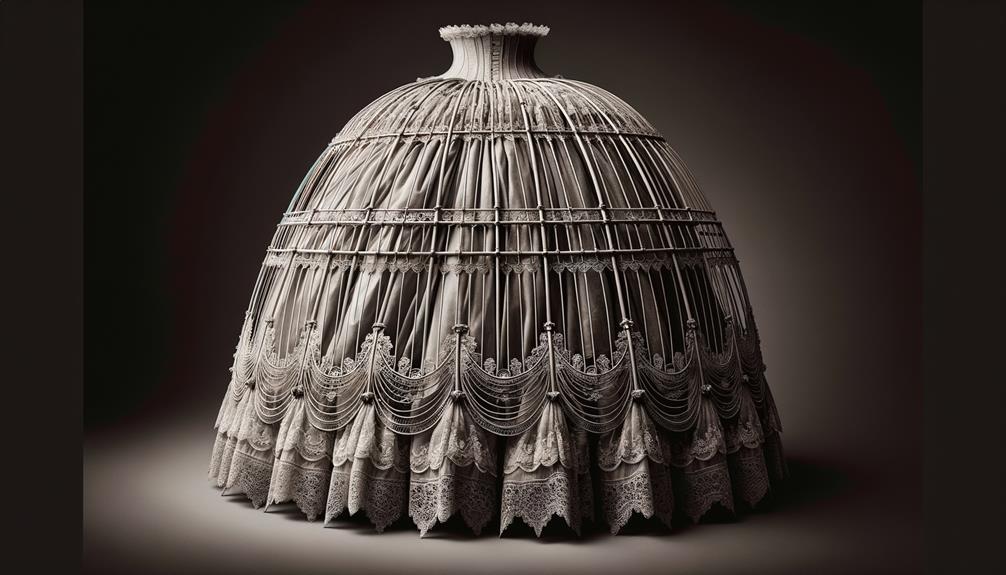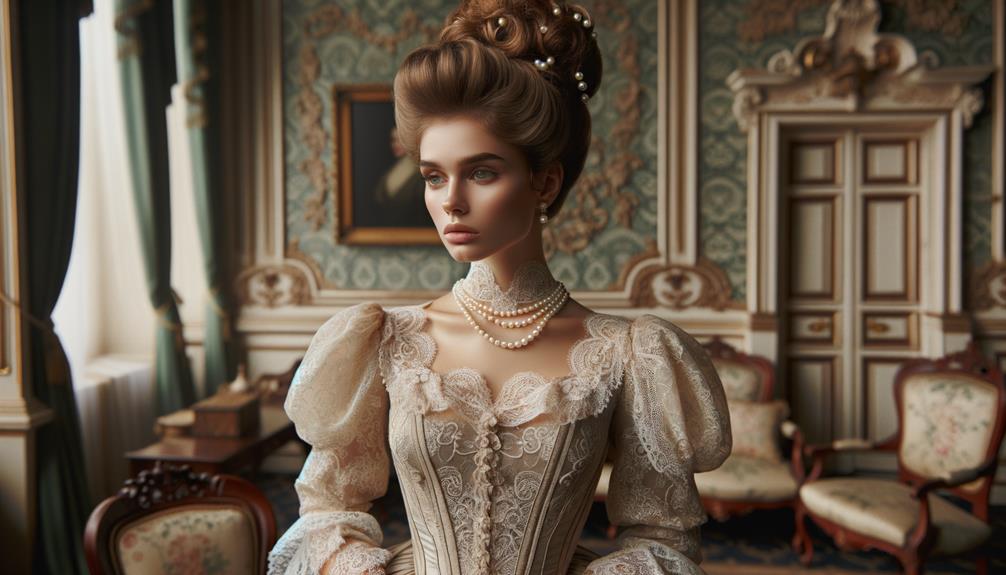I appreciate the opulence and femininity embodied in lace on Victorian gowns. The intricate floral patterns, crafted through bobbin and needle lace techniques, exude affluence and elegance. Chantilly and Alençon lace add refined touches to evening wear and bridal gowns, while Irish crochet lace showcases impressive artistry. Each gown's scalloped edges and beaded details transform them into timeless masterpieces. The lace tells stories of a rich tradition and speaks to the wearer's refined taste and social standing. It's fascinating how these elements continue to inspire modern fashion, with their influence still visible beneath the surface.
History of Victorian Lace
Exploring the history of Victorian lace, I've uncovered a rich tapestry woven with tradition and innovation. The intricate techniques of bobbin lace and needle lace brought delicate floral patterns to life on lace gowns. Each piece, whether a collar or cuff, embodied luxury and femininity.
Queen Victoria's love for white lace sparked a trend that transformed bridal attire. Her influence permeated fashion, making lace gowns a staple in every woman's wardrobe. The scalloped edges and intricate beadwork on these gowns exuded a romantic aesthetic that defined the era.
During the 19th century, the lace-making industry flourished. Centers in Belgium, France, and England produced high-quality lace that became the hallmark of Victorian fashion. Skilled artisans created masterpieces that went beyond mere decoration. Lace became a status symbol, whispering affluence and taste.
Studying Victorian lace reminds me of the craftsmanship and artistry that defined an era. It's a testament to how innovation often finds its roots in tradition.
Types of Lace Used
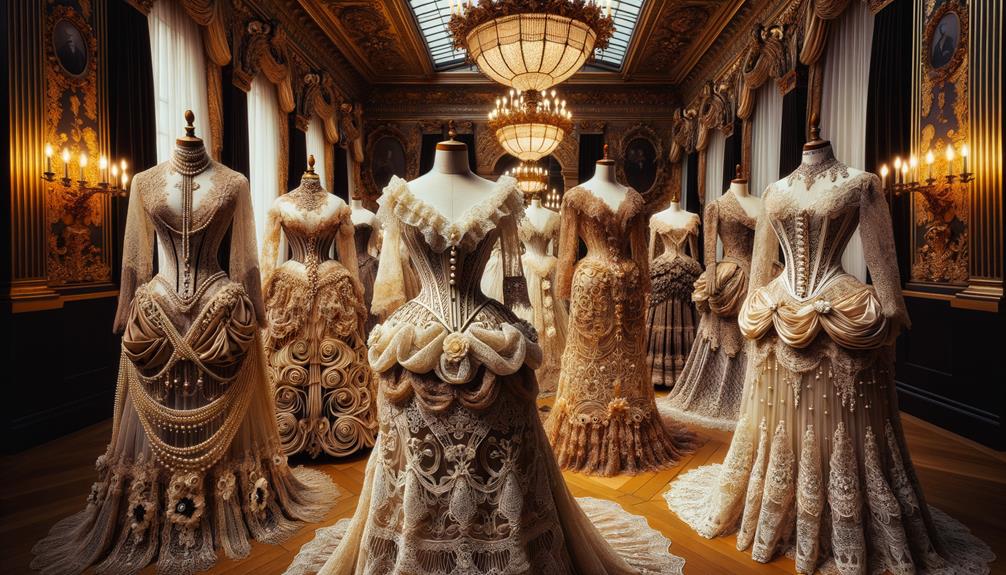
Lace played a significant role in Victorian fashion, with various types adding unique charm and sophistication to garments. Irish crochet lace, with its delicate floral motifs, showcased exceptional craftsmanship. Duchess lace, featuring luxurious raised floral designs, was often reserved for special occasions.
Chantilly lace, known for its fine netting and intricate patterns, brought an air of elegance to evening wear. Alençon lace, with its needlework and corded details, provided a more structured look. Valenciennes lace, featuring fine mesh and simple motifs, was commonly used for trims and accessories.
Machine-made net lace gained popularity in the late Victorian era due to its affordability and delicate appearance, making it accessible to a broader audience. However, handcrafted lace remained highly valued for its uniqueness and craftsmanship. Point d'Angleterre lace, renowned for its fine needlework, was a high-quality choice for those who could afford it.
Each type of lace contributed to the rich tapestry of Victorian fashion, blending tradition with the era's evolving tastes.
Lace in Wedding Gowns
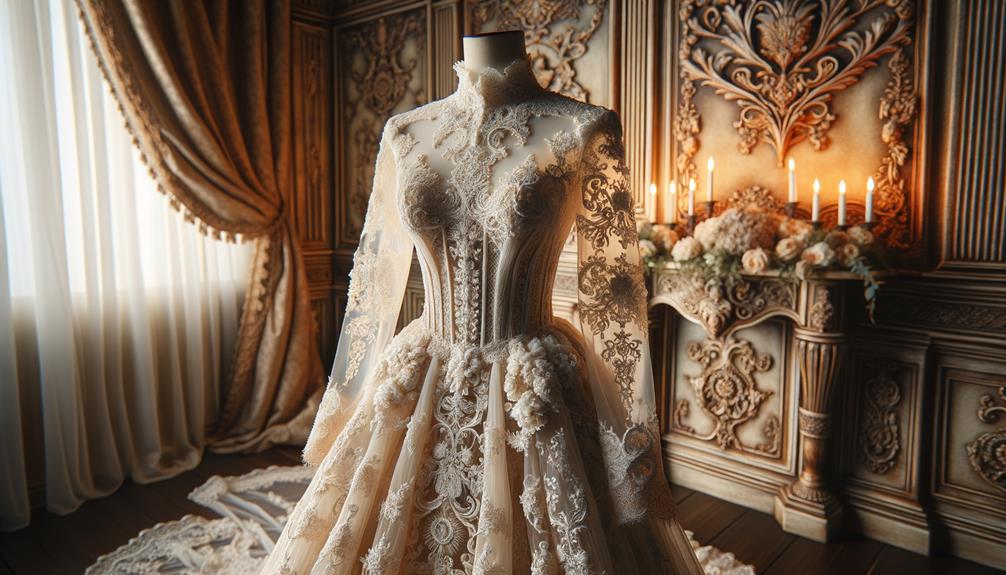
In the world of wedding gowns, lace reigns supreme. The intricate details of a lace wedding dress epitomize elegance and romance, with each stitch a testament to craftsmanship. The Victorian era was particularly renowned for its meticulous attention to detail, which found perfect expression in these bridal masterpieces. Delicate Floral Lace patterns symbolized purity and femininity, elevating the bride's appearance to an otherworldly level.
When I look at a Victorian lace wedding dress, I'm struck by the harmony between simplicity and opulence. Scalloped edges frame the dress with grace, while intricate floral motifs cascade down the fabric. Each element contributes to a cohesive and stunning ensemble, blending tradition with innovation. The lace isn't just a decoration; it's the heart of the gown, whispering stories of love and commitment.
The bride's lace veil, an accessory that complements her gown, adds another layer of sophistication. It creates a seamless blend between the dress and the overall bridal look, enhancing the sense of unity. Victorian brides knew how to use lace to its fullest potential, ensuring every detail, from the veil to the hem, exuded timeless beauty. This mastery of lace continues to inspire modern bridal fashion.
Lace Detailing Techniques
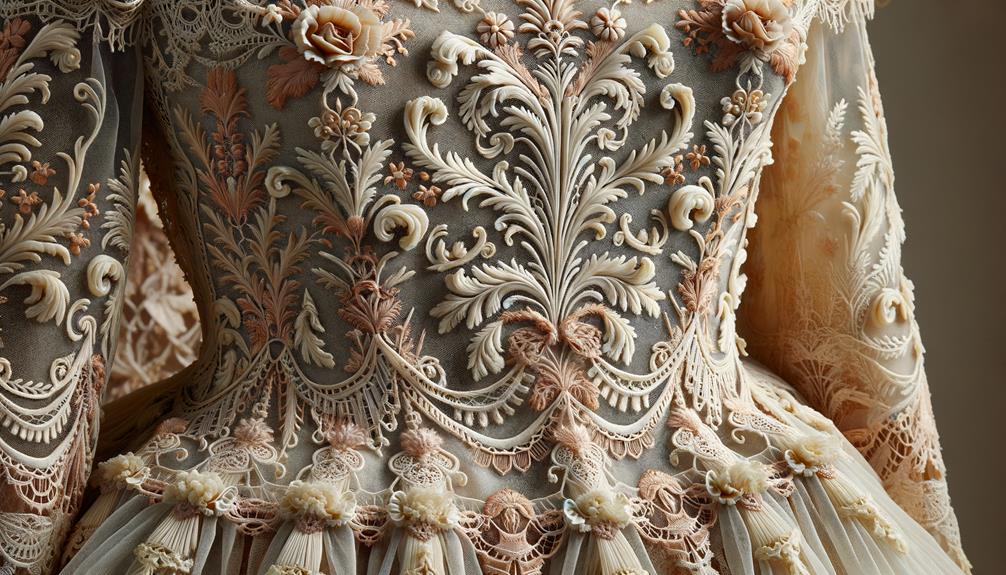
In the delicate world of Victorian fashion, intricate lace detailing was a testament to the era's exceptional craftsmanship. Each gown was a canvas, brought to life through meticulous techniques that turned plain white cotton into stunning works of art.
To appreciate these techniques, consider the following:
- Needle Lace: This lace featured motifs that were often hand-stitched onto sleeves and hems using a needle and thread.
- Bobbin Lace: Artisans wove intricate patterns using multiple bobbins, adorning collars and cuffs with an air of sophistication.
- Chantilly Lace: Known for its delicate floral design, this lace added a romantic touch, often seen as a premium lace overlay on the bodice.
The precision with which these techniques were applied is astonishing. Lace trim wasn't merely sewn; it was an art form that symbolized luxury and femininity. Each piece of lace was a representation of the skill and patience of the artisans. The resulting gowns weren't just clothing; they were statements of elegance and refinement.
Embracing these techniques today could lead to innovative designs, blending timeless beauty with modern sensibilities. Victorian fashion's lace detailing continues to inspire, offering a glimpse into an era where artistry knew no bounds.
Influence on Modern Fashion
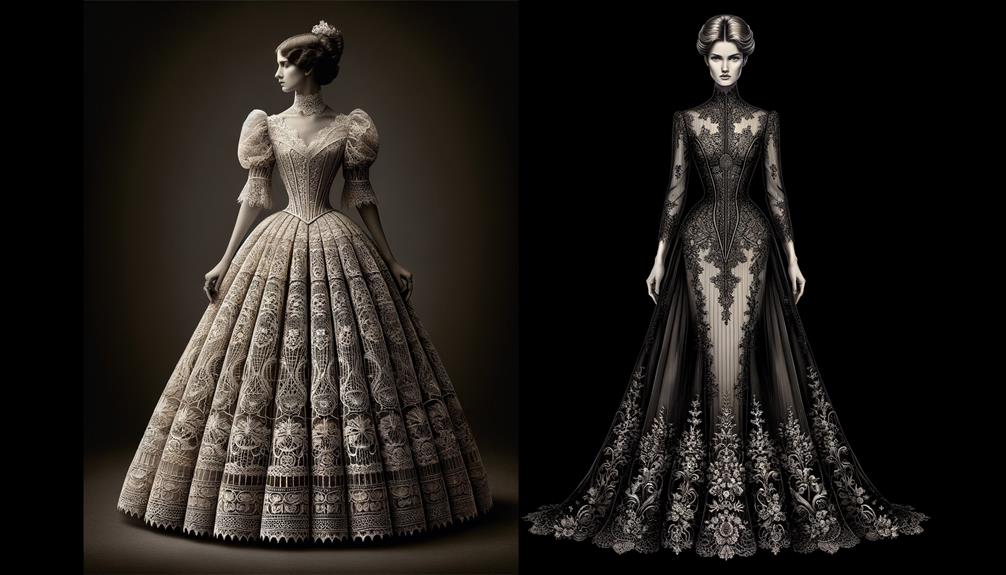
Victorian lace detailing continues to leave a lasting mark on modern fashion. Its intricate artistry whispers through the threads of contemporary designs, captivating audiences worldwide. You can see this influence in the lace detailing on dresses, blouses, and accessories.
Designers often draw from Victorian-inspired patterns and techniques, creating clothing that exudes timeless elegance. This isn't just nostalgia; it's a tribute to the era's sophistication. Lace detailing, once a hallmark of the Victorian era, now enriches both casual and formal wear.
The delicate nature of Victorian lace continues to capture the imagination of fashion enthusiasts and designers worldwide. Its presence in bridal fashion is particularly notable. Many brides opt for lace-detailed gowns that echo the sophistication of the Victorian era.
| Element | Victorian Era | Modern Fashion |
|---|---|---|
| Patterns | Intricate, Floral | Victorian-inspired, Versatile |
| Usage | Gowns, Accessories | Dresses, Blouses, Accessories |
| Techniques | Handcrafted, Detailed | Adapted, Innovative |
| Popularity | High among elites | Widespread, Global |
| Bridal Fashion | Essential, Symbolic | Timeless, Romantic |
Observing these trends, I realize that the elegance and artistry of Victorian lace detailing will always leave a significant imprint on modern fashion.
Frequently Asked Questions
Did Victorians Wear Lace?
Victorians were known for their exquisite taste in fashion, and lace was a staple in their wardrobe. The intricate patterns and delicate details of lace adorned their gowns, reflecting their love for elegance and refinement. It wasn't just reserved for special occasions; lace was a common feature in everyday wear, symbolizing sophistication and accessibility.
What Did Victorian Ladies Wear Under Their Dresses?
Victorian ladies wore multiple layers under their dresses, including chemises, drawers, corsets, petticoats, and sometimes bustles. Each layer served a specific purpose, such as providing protection, modesty, shape, and structure. The complexity of their attire reflected the societal norms and fashion of the time.
What Are the Parts of a Victorian Dress Called?
I saw a stunning Victorian dress at a museum, and it left a lasting impression on me. The fitted bodice, flowing skirt, and leg-of-mutton sleeves worked together to create a timeless elegance that continues to inspire modern designers today.
What Fabric Were Victorian Dresses Made Of?
Victorian dresses were made of luxurious fabrics like silk, satin, and velvet to showcase social status. For everyday wear, cotton provided a comfortable alternative. Each fabric choice served a purpose, balancing elegance and practicality in an era of opulence.



